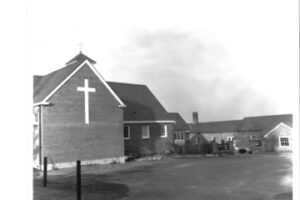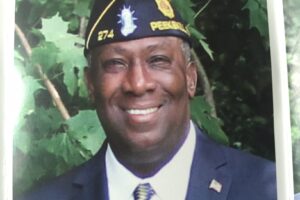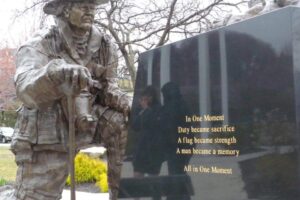When I was in grade school, I was taught something that was very interesting. It was very puzzling at the time because I could not quite visualize it when I was a boy.
 What I learned was that ships used to sail from the Hudson River all the way up to the mill at Philipsburg Manor. This interesting piece of information was imparted to me at F. R. Pierson School. Pierson School was the elementary school in Tarrytown, before Tarrytown and North Tarrytown (Sleepy Hollow) consolidated their schools in 1957. Pierson School housed K through 6th grade at this time, before John Paulding and Tappan Hill Schools were built. Pierson School, built in 1898, was the original Washington Irving High School. It was constructed on the site of the Van Tassel homestead and contained the original door of Katrina Van Tassel’s home. You will probably recall that Katrina Van Tassel and her father’s wealth caught Ichabod Crane’s interest in Washington Irving’s Legend of Sleepy Hollow. This Elizabethan building is located in the center of town, with the WW I monument in front of it. Today, it is the Landmark Condominiums.
What I learned was that ships used to sail from the Hudson River all the way up to the mill at Philipsburg Manor. This interesting piece of information was imparted to me at F. R. Pierson School. Pierson School was the elementary school in Tarrytown, before Tarrytown and North Tarrytown (Sleepy Hollow) consolidated their schools in 1957. Pierson School housed K through 6th grade at this time, before John Paulding and Tappan Hill Schools were built. Pierson School, built in 1898, was the original Washington Irving High School. It was constructed on the site of the Van Tassel homestead and contained the original door of Katrina Van Tassel’s home. You will probably recall that Katrina Van Tassel and her father’s wealth caught Ichabod Crane’s interest in Washington Irving’s Legend of Sleepy Hollow. This Elizabethan building is located in the center of town, with the WW I monument in front of it. Today, it is the Landmark Condominiums.
At any rate, as a boy I wondered about those ships sailing up to the old mill and it wasn’t until I was a little older, that I realized that a great deal of the Hudson River had been filled in around Tarrytown and Sleepy Hollow. I learned from a turn-of-the-century map of Tarrytown, that there was a small cove directly behind the railroad tracks, just south of the train station, and that the cove was filled so that warehouses could be constructed for the railroad. The cove was filled to where Franklin Courts stands today. If you visit Franklin Courts, and look on the east side, you can very distinctly see what was once the shore of the Hudson River, and you can still find many oyster shells there. At the foot of Main Street was the wharf for the Tarrytown-Nyack Ferry. From that wharf, all the way to Wildey Street, had all been filled in over the years.
On a more personal note, I remember that when I was a young boy, the Hudson River just south of Main Street began to be used by the Village as a dump.
Cement slabs, refrigerators, old washing machines, etc. were thrown in to form landfill that would become Pierson Park, the commuter parking lot next to the Tarrytown Boat Club, and Losee Park. In fact, I recall a road running parallel to the railroad tracks, along the river, that led to a footbridge that went out to the Tarrytown Boat Club which was built on pilings. Everything between was once part of the Hudson River. Heading north towards Sleepy Hollow, there was a bay just south and east of Kingsland Point Park called Slapershaven, which meant Sleepy Harbor in Dutch. Silt that ran off nearby farms began to fill in Slapershaven for more than a hundred years. Then, in the mid-nineteenth century, the Hudson River Railroad, which later became the New York Central Railroad, filled in part of the harbor to lay their tracks as they proceeded north to Albany.
In 1899, John Brisben Walker began to fill in the river as his factory, designed by Stanford White, was built to house his Mobile Steam Company of America. After a few years, as the internal combustion engine began to become popular, Walker went out of business, and the Stanford White factory was taken over by the Maxwell-Briscoe automobile company. They too went out of business, leading the way for General Motors to begin manufacturing in the area in 1923. By the time that General Motors left Sleepy Hollow in 1996, they had filled in 97 acres of the Hudson River. By doing this over a number of years, General Motors completely altered the course of the Pocantico River that runs through Rockefeller’s property, continues through Sleepy Hollow Cemetery, flows under Route 9, and turns the waterwheel at Philipsburg Manor. By continually filling in Sleepy Harbor, the Pocantico River was pushed north, and now runs as a small stream under the bridge by the ticket booth at the entrance to Kingsland Point Park. The environmental group, Scenic Hudson, would like the Pocantico River returned to its original course.
My father was captain of the Research Vessel Manning that was docked in Dobbs Ferry at Hudson Laboratories. The R/V Manning was funded by Columbia University and the Office of Naval Research, and took core samples of the Hudson River, often in areas that had been filled. By studying the core samples, the rate of pollution and river fill could be measured back to when Henry Hudson discovered the river in1609. This research was begun before the Clearwater sloop made the public aware of how polluted the Hudson River had become.
In the early seventies, the lifeboat from the R/V Manning was to be discarded or destroyed because it was more than forty years old and in need of great repair. To my great fortune, instead of throwing the lifeboat out, my father gave it to me and after repairing its bottom one winter, it was ready for the Hudson by spring. I now had a boat and was determined to follow today’s course of the Pocantico River.
On my first attempt, I quickly learned that this would be absolutely impossible at low tide because the current was ebbing so quickly that I could not row against it. More importantly, the water was too shallow, exposing too many rocks. However, I persisted when the tide was high, and rowed under the Kingsland Point bridge, the bridge for the Metro North tracks, through some very narrow passages, sometimes having to cut branches that had fallen across the river, and finally arrived at the waterwheel at Philipsburg Manor. I was finally able to see for myself what I had learned so long ago at Pierson School. Even though the course of the Pocantico River had been changed, I could understand how ships could indeed have sailed from the Hudson River, up the Pocantico River, to the old mill.
Richard Miller,
Tarrytown Village Historian







